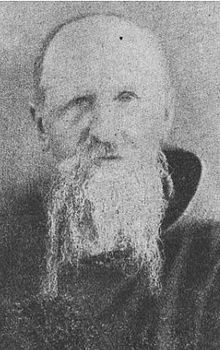Félix José de Augusta
Fray Félix José de Augusta , Hispanic from Felix Joseph von Augsburg , born August Stephan Kathan (born December 26, 1860 in Augsburg , † November 16, 1935 in Valdivia , Chile ) was a German surgeon , missionary of the Capuchin order and linguist who worked through his works on the Mapudungun , the Mapuche language , became famous.
life and work
Brother Felix was baptized as August Stephan Kathan. He was the fourth son of Johan Michael Kathans, a businessman and free thinker from Augsburg. He attended Benedictine - high school at St. Stephen , while he simultaneously studied music, until the convent of St. Ursula and later at the Conservatory of the city. He then began studying medicine in Würzburg , which he completed in Munich . He then practiced for a time at an Augsburg hospital. Finally, after completing his military service in the army hospital in the same city, he asked to be admitted to the Capuchin Order. Membership was granted to him on March 6, 1887. He took the name Felix Joseph von Augsburg and after a shortened degree in theology at the University of Dillingen he was ordained a priest on August 2, 1890.
In 1895 the Capuchins of the Bavarian province were assigned the mission of the Araucanian region in Chile. Brother Felix was one of the first to volunteer for the mission. He was among the first four Capuchins to meet in Valdivia on December 23, 1895.
From then on known by the Hispanic form of his name, Fray Félix José de Augusta, he devoted himself to evangelizing and educating the Mapuche until his death , and advocated their rights and culture. But he put his main focus on the Mapudungun (still commonly known as Araucanian in his day).
For this he acquired an enormous amount of specialist knowledge, about the language itself and, although it was not his main interest, about the scientific description of the language. He also wrote several works, such as the Gramática Araucana (1903), the Lecturas Araucanas (1910, in collaboration with Brother Sigifredo de Fraunhäusl ) and the Diccionario Araucano-Español, Español-Araucano (1916, in two volumes).
Even after the first-class pedagogical Gramática Araucana was published, it was regarded by the Chilean Araucanists as the greatest competence. His most important work and still authoritative in Araucanic studies today is the two-volume dictionary.
Other works (selection)
- Dios ñi dangu , 1902
- Nidolke d ɘŋu Dios ñi Nùtram , 1903
- Historia Sagrada de FJ Knecht (Araucanian version), 1903
- Komunion Rezan , 1907
- Apéndice al Ritual Romano para los Araucanos , 1907
- Kiñewn amuaiyu , 1925
literature
- Adalberto Salas : Fray Félix José de Augusta: Su aporte a los estudios de la lengua y la cultura de los mapuches o araucanos . In: Cultura-Hombre-Sociedad . Vol. 2, Num. 2, Universidad Católica de Temuco. 1985
Web links
- Gramática Araucana , on the Internet Archive
- Lecturas Araucanas , in memoriachilena (Biblioteca Nacional de Chile)
- Diccionario Araucano-Español y Español-Araucano, on the Internet archive :
- Araucano-Español (Volume 1)
- Español-Araucano (Volume 2)
Individual evidence
- ↑ Familia , July 1926, page 14 (note: several issues of the magazine are bound together in the PDF, the article about Brother Felix with the photo is on page 344 of the PDF file)
| personal data | |
|---|---|
| SURNAME | Augusta, Félix José de |
| ALTERNATIVE NAMES | Augsburg, Felix Joseph von; Kathan, August Stephan (maiden name) |
| BRIEF DESCRIPTION | German surgeon, missionary of the Capuchin order and linguist |
| DATE OF BIRTH | December 26, 1860 |
| PLACE OF BIRTH | augsburg |
| DATE OF DEATH | November 16, 1935 |
| Place of death | Valdivia , Chile |
